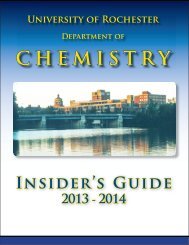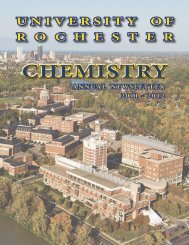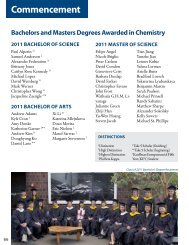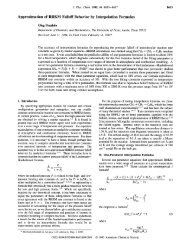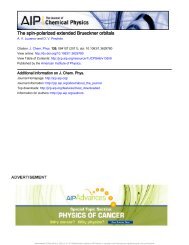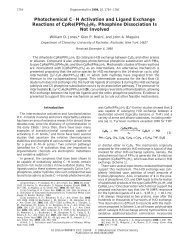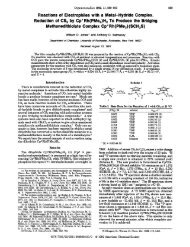Organometallics 2010, 29, 2430â2445 - Chemistry - University of ...
Organometallics 2010, 29, 2430â2445 - Chemistry - University of ...
Organometallics 2010, 29, 2430â2445 - Chemistry - University of ...
Create successful ePaper yourself
Turn your PDF publications into a flip-book with our unique Google optimized e-Paper software.
Article <strong>Organometallics</strong>, Vol. <strong>29</strong>, No. 11, <strong>2010</strong> 2439<br />
Figure 13. (a) ORTEP drawing <strong>of</strong> Ni(dippe)(1,2-η 2 -1,4-dicyanonaphthalene) (G3). Ellipsoids are shown at the 50% probability level.<br />
Selected bond lengths (A˚ ): Ni(1)-C(1), 1.9794(11); Ni(1)-C(2), 1.9765(12); Ni(1)-P(1), 2.1866(4); Ni(1)-P(2), 2.1807(4); C(1)-<br />
C(11), 1.4404(16); C(11)-N(1), 1.1557(16); C(1)-C(2), 1.4556(16); C(2)-C(3), 1.4221(17); C(3)-C(4), 1.3704(18); C(4)-C(12),<br />
1.4336(17); C(12)-N(2), 1.1522(17). Selected angles (deg): P(1)-Ni(1)-P(2), 92.092(15); C(2)-Ni(1)-C(1), 43.18(5); C(1)-C(11)-<br />
N(1), 178.43(14); C(4)-C(12)-N(2), 178.85(15). (b) ORTEP drawing <strong>of</strong> Ni(dippe)(CN)(4-CN-naphthyl) (G13). Ellipsoids are shown<br />
at the 50% probability level. Selected bond lengths (A˚ ): Ni(1)-C(1), 1.933(3); Ni(1)-C(12), 1.877(3); Ni(1)-P(1), 2.1847(8); Ni(1)-<br />
P(2), 2.1915(9); C(12)-N(2), 1.137(4). Selected angles (deg): P(1)-Ni(1)-P(2), 88.32(3); C(12)-Ni(1)-C(1), 88.95(12); N(2)-C(12)-<br />
Ni(1), 177.9(4); C(4)-C(11)-N(1), 178.6(4).<br />
Figure 14. Energetics <strong>of</strong> C-C bond activation <strong>of</strong> 1,4-dicyanonaphthalene by [Ni(dmpe)] (free energies in kcal mol -1 ) relative to the<br />
total energies <strong>of</strong> fragments ([Ni(dmpe)] and 1,4-dicyanonaphthalene) (PCM corrected in THF).<br />
The former has two doublets in the 31 P{ 1 H} NMR spectrum<br />
at δ 61.7 and 72.5 with J P-P = 68 Hz. The latter shows a pair<br />
<strong>of</strong> doublets at δ 55.6 and 62.6 with smaller coupling constant<br />
(J P-P = 58 Hz). In the corresponding 1 H NMR spectrum,<br />
the resonances for the η 2 -arene species are shifted upfield<br />
compared to the η 2 -nitrile species. When the temperature<br />
was increased to 30 °C, the η 2 -nitrile complex I1 completely<br />
converted into the η 2 -arene complex I2. A single-crystal<br />
X-ray structure for the η 2 -arene complex was obtained<br />
(Figure 17), which showed nickel coordinating to the CdC<br />
double bond next to the cyano substituent. Upon heating to<br />
120 °C for 1 week in THF, no C-CN cleavage was observed.<br />
Upon irradiation for 30 min, the oxidative addition product<br />
I18 appeared in the 31 P{ 1 H} NMR spectrum, with two sharp<br />
doublets at δ 65.8 and 75.7 with J P-P = 21 Hz. After<br />
irradiation for 36 h, only about 27% <strong>of</strong> I18 was formed,<br />
and upon heating at 120 °C for 1 h, it was completely<br />
converted back to I2.<br />
Results from DFT calculations are summarized in Figure<br />
18. The η 2 -nitrile species SI1 is about 1.4 kcal/mol higher in<br />
energy than the η 2 -arene species SI2. While both adducts<br />
could be observed at low temperature, upon warming, SI2 is<br />
calculated to be preferred thermodyanically, consistent with<br />
the experimental observations. All other possible η 2 -arene




